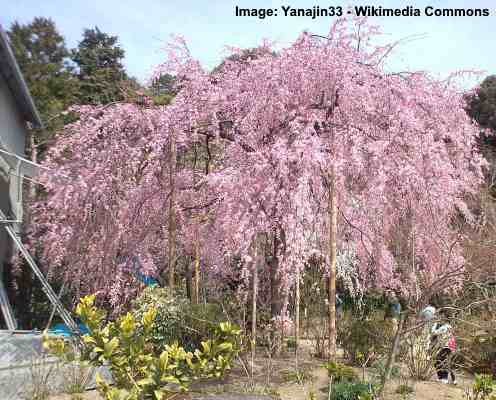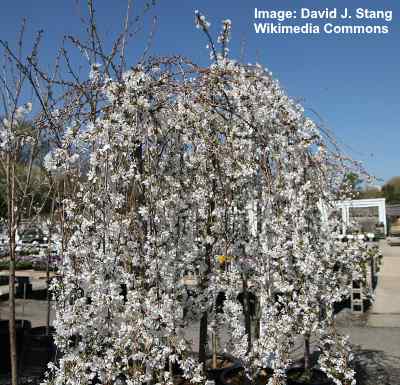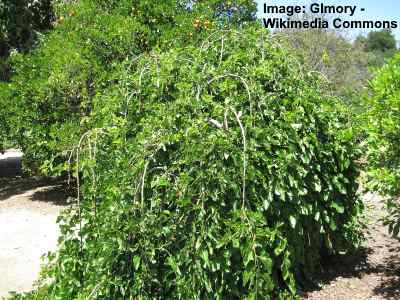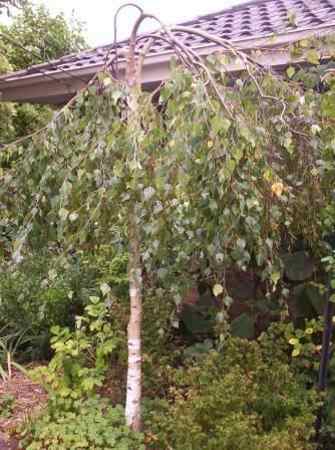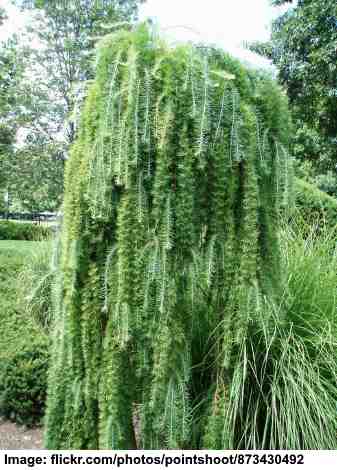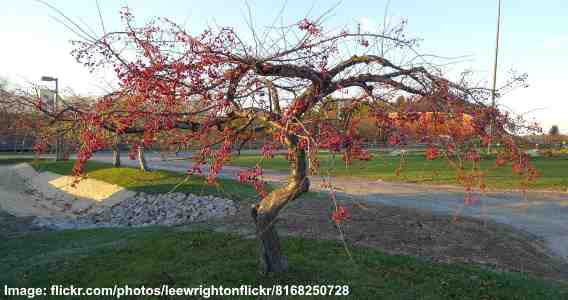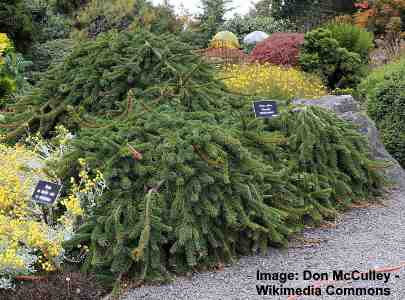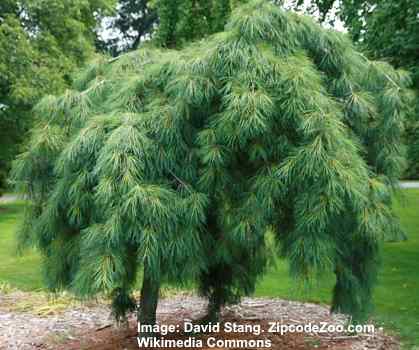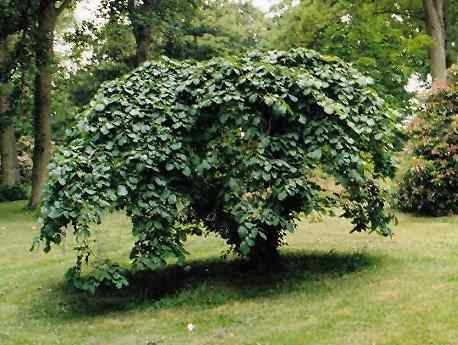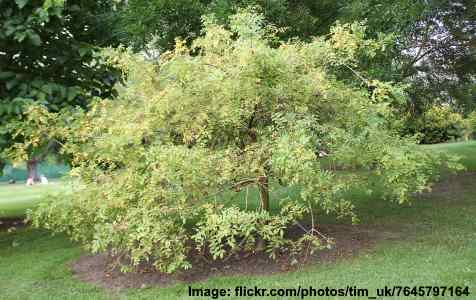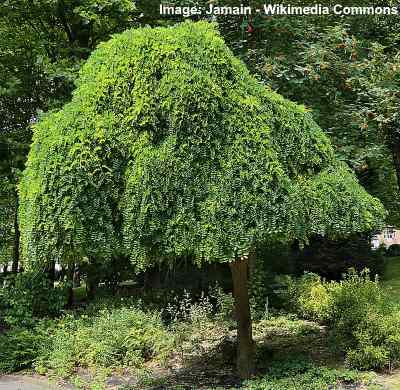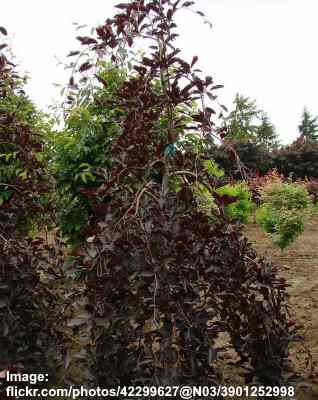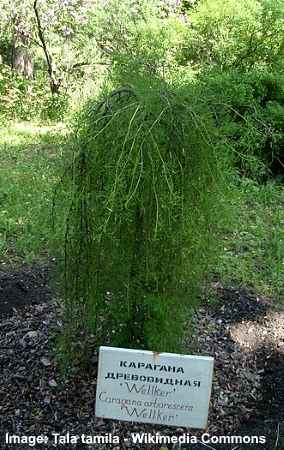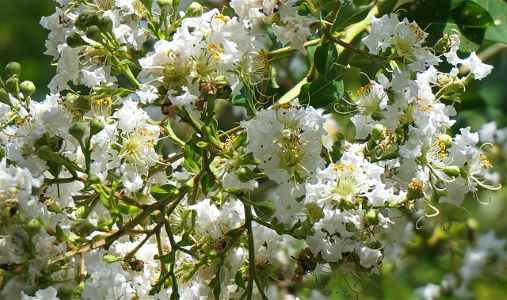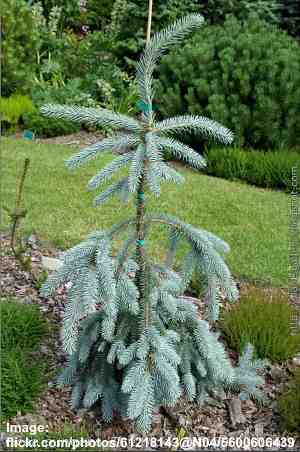Small or Dwarf Weeping Trees for Landscaping (With Pictures)
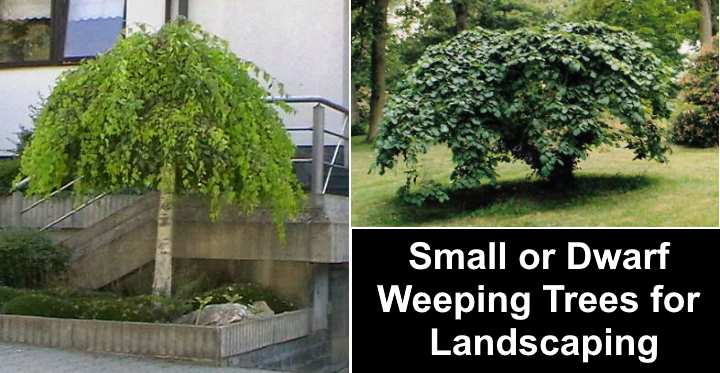
Weeping trees have long drooping branches that cascade towards the ground. Some weeping trees occur in nature, but most of them are cultivars. Weeping trees often carry the cultivar name “Pendula” because of their droopy branches. Very often, the common names of these trees have the word “weeping” in their name.
Small weeping trees add grace and elegance to small landscaped gardens. Their long cascading, drooping branches are good landscaping choices as specimen trees to create a focal point. If you have a small front or backyard and garden space is limited, then small or dwarf weeping trees will add a dramatic look.
Examples of some small deciduous weeping trees include types of birch trees, cherry trees, willows, weeping redbud and maples, which have stunning foliage that grabs attention. Other dwarf evergreen weeping trees such as species of junipers, spruces, and cedar have drooping branches that stay green all year long.
When choosing a type of small weeping tree for your backyard, it’s important to consider where it will grow. There are many different types of small weeping trees for any garden landscape in most growing zones. Most types of flowering weeping trees need full sun and partial shade. Some small evergreen weeping trees also like plenty of sunshine but may also survive shade and cold temperatures.
In this article, you will learn about the most stunning small and dwarf weeping trees for landscaping small yards. Along with their scientific names, pictures and descriptions of these small trees with drooping branches will help identify them.
Small or Dwarf Weeping Trees for Landscaping
If you want to landscape a small front or backyard, small weeping trees are excellent choices. Apart from their small height, weeping trees are very compact. Because their branches hang down rather than spread out, they don’t take up as much room.
Most dwarf and small weeping trees are best used as a specimen tree. These trees can add a focal point and drama to small yards without imposing on other plants.
It is also important to take into consideration if the trees flower, the color of foliage, when they shed their leaves, and their light requirements.
Small Weeping Trees for Landscaping (With Pictures)
Let’s look at some examples of stunning cascading trees that are small enough for tiny gardens and yards.
Weeping Cherry Tree (Prunus pendula)
One of the most beautiful varieties of small weeping trees is the weeping cherry tree. This small flowering tree has long arching branches that droop, forming a wide crown. The beauty of the weeping cherry tree is the rose-pink flowers that blossom in late winter and early spring.
This decorative cherry tree with its pendulous branches doesn’t produce edible fruit. Dark green ovate shaped leaves provide shade in summer before turning orange in the fall.
The fast-growing ornamental tree grows between 15 and 25 ft. (4.5 – 7.6 m) tall, has a wide spread and enjoys full sun.
If your space is really small, you can try the dwarf-sized weeping cherry tree Prunus ‘Snow Fountain’ which grows to between 8 and 15 ft. (2.4 m – 4.5 m) and has stunning small white flowers. These ornamental small trees grow well in zones 3 – 8 and enjoy full sun and partial shade.
Mature Size: 15 – 25 ft. (4.5 – 7.6 m)
USDA Hardiness Zones: 3 – 8
Sun: Full sun to partial shade
Weeping Eastern Redbuds (Cercis canadensis ‘Ruby Falls’ and ‘Lavender Twist’)
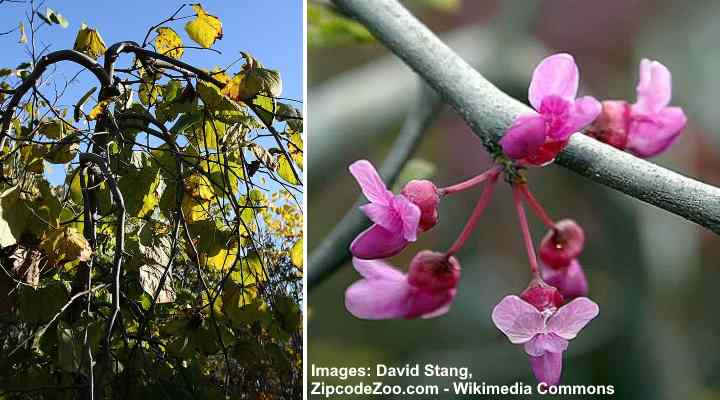
These images show Eastern redbud ‘Lavender Twist’ (also called ‘Covey’) which is a dwarf weeping cultivar of Eastern redbud tree
Eastern redbuds (Cercis canadensis) are ornamental deciduous trees native to eastern North America. The eastern redbud cultivars ‘Ruby Falls’ and ‘Lavender Twist’ are small weeping trees and as such they are a great choice when space is limited.
Ruby Falls weeping redbud tree has beautiful pink flowers that come every spring, followed by dark green-burgundy colored heart shaped leaves that turn yellow in autumn. It is a great choice as a decorative tree in a small garden.
Weeping redbud ‘Ruby Falls’ grows up to 6 ft. (1.8 m) tall with crown width of around 4 ft. (1.2 m) wide. This redbud thrives in full sun to part shade and in well draining soil. ‘Ruby Falls’ redbud is hardy in USDA zones 5-9.
Eastern redbud ‘Lavender Twist’ is another small weeping redbud cultivar which is also called Cercis canadensis ‘Covey’. This is a slow growing dwarf ornamental weeping tree that can reach after many years 5 – 6.5 ft. (1.5 – 2 m) tall with similar width.
Lavender twist’ redbud has twisted trunk and branches, with small pink-purple flowers that bloom in early spring. It has green heart shaped leaves that turn yellow in autumn.
Similar to the ‘Ruby Falls’ cultivar, ‘Lavender Twist’ weeping redbud requires full sun to part shade and well draining soil. Lavender twist redbud is more winter hardy than ruby falls redbuds and can even survive temperatures as low as -23F (-30C).
Mature Size: 4 – 10 ft. (1.2 – 2 m) – depending on cultivar
USDA Hardiness Zones: 4 – 9
Sun: Full sun to partial shade
Weeping Mulberry (Morus alba ‘Chaparral’)
Also called the white mulberry, the ‘Chaparral’ cultivar is a dwarf tree with arching weeping branches that grows to about 6 ft. (1.8 m) tall. This is an easy-to-grow small bush-like tree with short stature.
Foliage on this small cascading tree is dense due to large dark glossy green leaves. The arching branches are so long that they droop down to reach the ground. The most common reason for planting a white mulberry is as a small specimen tree.
The common name of this dwarf weeping tree, ‘white mulberry,’ comes from the color of its ripe fruits. These fruits, similar to blackberries, turn white when fully ripened.
The weeping mulberry is perfect for small backyards if you live in zones 4 to 8. The tree needs full sun to partial shade and can thrive in most soils.
Mature Size: Up to 6 ft. (1.8 m)
USDA Hardiness Zones: 4 – 8
Sun: Full sun to partial shade
Weeping Juniper Tree (Juniperus scopulorum ‘Tolleson’s Blue Weeping’)
Weeping junipers are popular trees in landscaped gardens due to their soft evergreen foliage that seems to just hang off branches. The leaves are needle-like and have a bluish-green color.
Planting a weeping juniper as a specimen plant gives a yard with limited space an exotic look. The romantic grace of this juniper cultivar with its gently arching branches is good where it can grow freely. The needle leaves on the pendant branches give off a fresh aroma.
The ‘Tolleson’s Blue Weeping’ juniper can grow up to 20 ft. (6 m) and has a spread of up to 10 ft. (3 m). The tree grows well in zones 4 to 7.
Mature Size: Up to 20 ft. (6 m)
USDA Hardiness Zones: 4 – 7
Sun: Full sun
Weeping Blue Atlas Cedar (Cedrus atlantica ‘Glauca Pendula’)
The Latin name of this cedar cultivar tells you that it is a type of weeping evergreen. The drooping branches are densely covered with clusters of silvery-blue needles which just add to its grace and charm.
There are a few reasons why this is a popular landscaping weeping evergreen. This weeping cedar is a fast-growing evergreen and it is easy to prune and shape the pendulous branches. You can train the tree to grow narrow and upright or have the cascading branches form an archway.
Depending on its training, the ‘Glauca Pendula’ cedar grows to between 3 and 12 ft. (0.9 – 3.6 m) tall. Thrives in full sun when growing in zones 6 – 9.
Mature Size: 3 – 12 ft. (0.9 – 3.6 m)
USDA Hardiness Zones: 6 – 9
Sun: Full sun
Weeping Birch Tree (Betula pendula ‘Youngii’)
This weeping birch cultivar is a smaller version to the traditional silver birch tree with drooping branches. The arching pendulous branches grow to give the tree a pyramidal or oval shape. The branches have glossy green leaves which are ovate shaped.
The dome shape and dense foliage of the weeping birch ‘Youngii’ make this a good small tree for privacy or as a windbreak in small yards. This is also classed as a good specimen tree for small landscaped yards in cool climates.
This weeping silver birch cultivar, ‘Youngii,’ grows to between 13 and 26 ft. (4 – 8 m) in zones 2 to 7.
Mature Size: 13 – 26 ft. (4 – 8 m)
USDA Hardiness Zones: 2 – 7
Sun: Full sun to partial shade
Weeping Japanese Larch (Larix kaempferi ‘Diana’)
Native to Japan, this interesting type of larch is a weeping deciduous conifer that has hanging branches. Although this weeping tree can grow to around 25 ft. (7.6 m) tall, it is slow growing in the first 10 years and stays relatively small.
As with most types of conifers, the Japanese larch has leaves that are needle-like. Clusters of these soft green needles grow on pendulous branches that are twisted and contorted. As this is a deciduous weeping tree, the needles turn golden yellow in the fall before shedding.
This small weeping larch tree grows to about 6 ft. (1.8 m) in the first 10 years. Use in small garden landscapes that are in zones 4 to 7.
Mature Size: Up to 25 ft. (7.6 m)
USDA Hardiness Zones: 4 – 7
Sun: Full sun
Weeping Crabapple (Malus ‘Louisa’)
If you want to add a beautiful flowering tree that provides spring color to your small backyard, then plant a weeping crabapple tree.
These weeping fruit trees seem to provide color in your garden for most of the year. Red buds in early spring turn into stunning pink flowers and then become small golden apples. The yellowish-red apples stay on the tree for most of the winter.
The ornamental weeping crabapple tree ‘Louisa’ grows to between 12 and 15 ft. (3.6 – 4.5 m). These are also hardy trees that require little maintenance and grow well in zones 4 to 8.
Mature Size: 12 – 15 ft. (3.6 – 4.5 m)
USDA Hardiness Zones: 4 – 8
Sun: Full sun
Weeping Norway Spruce (Picea abies ‘Pendula’)
As its scientific name suggests, this species of spruce is a weeping type of evergreen landscape tree. In cold climates, the Norway spruce provides lush green color when not much else is growing.
This species of weeping evergreen can be used as a groundcover plant or trained to grow upright. As an evergreen with drooping branches, the spruce forms a pyramidal shape due to its pendulous branches. The fact that this is a thin type of evergreen means you can grow a few even in a small garden.
The weeping Norway spruce is much smaller than traditional spruces that can reach 100 ft. tall. The ‘Pendula’ weeping cultivar is a small evergreen that only grows around 10 ft. (3 m) high.
Mature Size: Around 10 ft. (3 m)
USDA Hardiness Zones: 3 – 7
Sun: Full sun
Weeping White Pine (Pinus strobus ‘Pendula’)
A stunning type of weeping evergreen is the Eastern White Pine ‘Pendula’. This weeping pine tree has some needle-like leaves that grow in clusters on the drooping branches. These can hang down so far that they also form creeping groundcover.
To grow the white pine into a small tree, the trunk needs to be stalked to make it grow upright. Soft blue-green needles grow densely on the pendulous branches. This fast-growing evergreen reaches up to 10 ft. (3 m) when mature.
The irregular growth pattern of pine cultivar ‘Pendula’ means that no two are alike. Plant in a small front or backyard as a showpiece specimen tree.
Grows well in zones 4 to 9.
Mature Size: Up to 10 ft. (3 m)
USDA Hardiness Zones: 4 – 9
Sun: Full sun to partial shade
Japanese Maple Tree (Acer palmatum ‘Red Dragon’)
If you are looking for a colorful small tree with branches that droop, then plant a Japanese maple in your garden. These small weeping trees are perfect for gardens with limited space or you can plant one in a container.
The ‘Red Dragon’ dwarf Japanese maple tree cultivar creates visual impact in a small yard. The small ornamental tree has rich red-purple leaves that look like dragon’s claws. From spring through summer, the colorful leaves turn bright red and then dark burgundy.
The arching pendulous leaves form a red cascading mound in your garden. Plant the tree in an area of your garden that enjoys full sun.
These colorful weeping small maple trees grow to between 6 and 8 ft. (1.8 – 2.4 m) tall and thrive in zones 5 to 8. The small ornamental trees also tolerate frost but need plenty of water in the summer and protection from cold winds.
Mature Size: 6 – 8 ft. (1.8 – 2.4 m)
USDA Hardiness Zones: 5 – 8
Sun: Full sun
Camperdown Elm (Ulmus glabra ‘Camperdownii’)
The Camperdown elm is a small tree with a weeping growth habit and contorted branches. The gently arching branches create a dome shape. Its rich dense foliage creates a great hiding place under its canopy.
Also called the Scotch elm, this small weeping tree will only grow to about 10 ft. (3 m) tall. Looking at pictures of this tree, it is easy to see why it also has the common name ‘umbrella tree.’ Its large domed top can have a spread of up to 30 ft. (9 m).
The Camperdown elm grows well in zones 4 to 6. As with many species of elm, this variety is susceptible to Dutch elm’s disease.
Mature Size: Around 10 ft. (3 m)
USDA Hardiness Zones: 4 – 6
Sun: Full sun to partial shade
Weeping Golden Ash (Fraxinus excelsior ‘Aurea Pendula’)
The ‘Aurea Pendula’ ash tree cultivar is classed as a small to medium-sized tree that produces mounds of weeping branches. The foliage on the droopy branches is light green which turns golden yellow in the fall.
Like many weeping trees on this list, the weeping golden ash can create an umbrella shape with its graceful arching weeping branches.
Plant in an area of your small yard that gets plenty of sun throughout the day. An excellent specimen tree for zones 5 to 7.
Mature Size: 9.8 – 19.6 ft. (3 – 6 m)
USDA Hardiness Zones: 5 – 7
Sun: Full sun
Weeping Pagoda (Sophora japonica ‘Pendula’)
This weeping tree gets its common name from the pagoda shape of this picturesque tree. The lush green foliage gently hangs down from the graceful tree. Although its scientific name would indicate it is from Japan, this weeping landscape tree is native to China.
Usually, the weeping pagoda can grow up to 15 ft. (4.5 m) tall, so it may not be suited for the smallest gardens. If your garden can accommodate this small weeping tree, you may get rewarded with beautiful white flowers in the summer.
This low-maintenance landscaping tree grows well in zones 4 to 8 and can tolerate a variety of soil conditions, including drought.
Mature Size: Up to 15 ft. (4.5 m)
USDA Hardiness Zones: 4 – 8
Sun: Full sun
Dwarf Weeping Trees for Landscaping (With Pictures)
If your garden is very restricted when it comes to space, your best choice would be to pick out a type of dwarf tree. These cultivars tend to be miniature trees that only grow a few feet tall.
Dwarf Weeping Willow (Salix integra ‘Pendula Waterfall’)
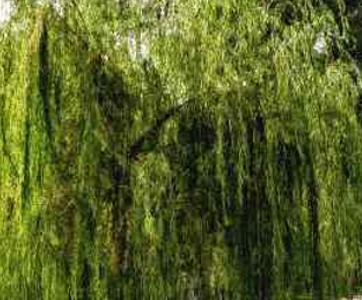
If you love the droopy look of weeping willow (in the picture), choose a dwarf cultivar for a small space
If you are looking for a miniature weeping tree for a yard with little space, then a dwarf weeping willow is a great choice. Compared to full-size weeping willows, this is a tiny tree with branches that droop.
The willow ‘Pendula Waterfall’ lives up to its name with gently cascading branches. This is a hardy willow tree that grows well in any type of soil. Its pendulous branches have bright green leaves that are slightly twisted. This is a perfect weeping tree for patios, balconies, and tiny gardens.
The dwarf weeping willow only grows as high as 5 ft. (1.5 m) in 20 years.
Mature Size: Up to 5 ft. (1.5 m)
USDA Hardiness Zones: 5 – 7
Sun: Partial sun
Dwarf weeping willow ‘Kilmarnock’
Related to the ‘Pendula Waterfall’ is the small ‘Kilmarnock’ weeping willow. This dwarf weeping deciduous tree grows to between 4 and 8 ft. (1.2 – 2.4 m) and has a distinct umbrella shape. The arching cascading branches form a canopy and the branches don’t reach the ground.
Mature Size: 4 – 8 ft. (1.2 – 2.4 m)
USDA Hardiness Zones: 4 – 8
Sun: Full sun
Weeping Copper Beech (Fagus sylvatica ‘Purpurea Pendula’)
With its dark foliage, this dwarf weeping beech tree cultivar makes a visual impact in any small backyard or front garden. Unlike other beech trees, this cultivar is very small and slow-growing.
The dwarf weeping beech tree has deep red to copper leaves that grow densely on cascading pendulous branches. This forms a mushroom shape and the stems arch up and droop to the ground. The red leaves turn deep purple in the summer and then golden bronze in the fall.
Grows well in zones 4 to 7 and is easy to grow in any size of garden.
Mature Size: Around 6 ft. (1.8 m)
USDA Hardiness Zones: 4 – 7
Sun: Full sun
Weeping Lindens (Tilia spp. ‘Pendula nana’)
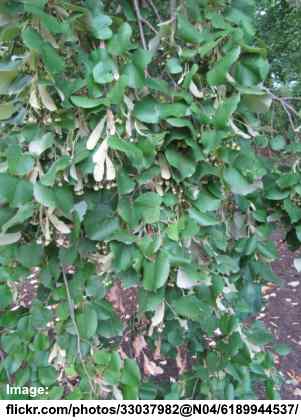
The small sized cultivars of weeping linden trees are good for landscaping limited spaces
Also named the penchant white lime, pendant silver linden, and weeping silver lime, this weeping cultivar is a nice specimen tree. Its small size makes it perfect for yards where planting space is restricted.
If you are looking to landscape a small backyard, you should also look for other dwarf weeping lindens cultivars such as ‘Girard’s Pendula Nana.’
Mature Size: 6.5 – 16.4 ft. (2 – 5 m)
USDA Hardiness Zones: 3 – 9
Sun: Full sun to partial shade
Siberian Peashrub (Caragana arborescens ‘Walker’)
This Siberian peashrub cultivar is a lovely weeping tree specimen for small front or backyards. The ‘Walker’ cultivar is an extremely hardy small tree that can grow even in harsh environments.
The cascading branches of this peashrub arch up and then droop straight down. When bright green leaves cover the tree in the spring, summer, and fall, the branches look weighed down by the foliage and yellow flowers.
This dwarf weeping tree grows to between 3 to 8 ft. (1 – 2.5 m) and is cold hardy in zones 2 – 7.
Mature Size: 3 – 8 ft. (1 – 2.5 m)
USDA Hardiness Zones: 2 – 7
Sun: Full sun
Crape Myrtle (Lagerstroemia indica x fauriei ‘Acoma’)
If you are looking for an attractive weeping tree for a small landscape, then the crape myrtle ‘Acoma’ cultivar is a great choice.
The crape myrtle ‘Acoma’ produces clusters of brilliant white flowers and glossy leaves adorn the cascading branches in the summer. This gives the multi-stemmed dwarf tree a look like a green and white bouquet of flowers.
The branches arch up and only slightly droop down on this semi-dwarf tree. You can expect the small tree to grow up to 10 ft. (3 m) tall.
The small weeping tree is ideal for flower beds, seating areas, or garden paths, allowing its beautiful flowers to be admired.
There are many other small crape myrtles that you can plant in your garden.
Mature Size: Up to 10 ft. (3 m)
USDA Hardiness Zones: 7 – 10
Sun: Full sun
Dwarf Weeping Colorado Spruce (Picea pungens ‘The Blues’)
A stunning example of a dwarf evergreen with leaves that droop is the Colorado spruce cultivar ‘The Blues.’ Having this as a small specimen tree in a yard with limited space will really make a statement.
It has silver-blue needle leaves on branches that hang down. The evergreen is classed as a dwarf weeper as it is slow-growing and only grows to about 6 ft. (1.8 m) tall. The lower branches can droop so low that they become rambling groundcover foliage. This is a dwarf weeping spruce that is extremely cold-hardy and grows in zones 2 to 8.
Mature Size: Around 6 ft. (1.8 m)
USDA Hardiness Zones: 2 – 8
Sun: Full sun
Weeping Scotch Laburnum (Laburnum alpinum ‘Pendulum’)
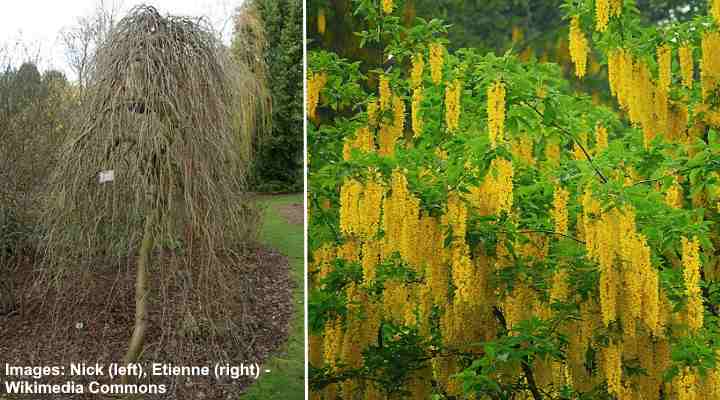
The weeping scotch laburnum is a stunning, deciduous tree with drooping branches. Its cascading branches form a round shape and are adorned with small, golden-yellow blossoms and light-green foliage.
You can use this tree as a decorative focal point in your garden, or you can train its pendulous branches to grow over an archway. Its compact size makes it a good choice for smaller yards.
The weeping scotch laburnum grows to between 20 to 25 ft. (6 – 7.6 m) tall and wide and is hardy down to USDA zone 5.
Related articles:

